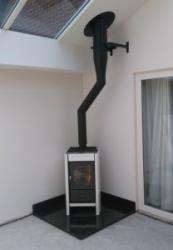Schiedel - Stove Installations in Conservatories
 Schiedel Stove Installations in Conservatories
Schiedel Stove Installations in Conservatories
Modern living trends include conservatory living as well, as people are staying in their homes rather than moving due to the current financial climate and choosing to enhance their living space.
The conservatory is an easy option to expand living space, as the building regulations are far more lenient, plus it’s an easy “add on” room without any major internal disruption.
With existing conservatories and new ones, the idea of having a wood burning stove is quite a desirable idea. A lot of conservatories tend to be naturally cold due to the number of windows, as well as almost non-existent insulation.
However, when adding a stove, the problematic issue is combustible UPVC parts, as well as combustible ceilings and roofs in general which tend to form a structure of a conservatory. An example of a flue existing the ceiling from Heatsource of Uppingham is shown on the main image. This is one solution and other solutions include the following:
An installation by A S Chimneys showing an ICID Plus twin wall system and Prima Smooth flue system in a new conservatory.
One of the main issues will be the exit through the roof for the flue itself. As conservatories tend to be UPVC, the worry is that the surroundings will melt over time.The solution is to adhere to distance to combustibles, as well as ingenuity in converting a panel to an A1 fire-rated material, which is a non-combustible material BS EN 13501-1.
For an existing conservatory, the advice is to remove the panel section where the chimney will pass through and then replace it with an A1 fire-rated material. The panel itself will need to be weatherproofed and sealed with A1 fire rated sealant.
A typical example of an installation was from A S Chimneys, and it showed that working in conjunction with the customer and conservatory supplier meant that the correct installation method was used, adhering to safety standards
The customer required the stove in the corner at 45 degrees, but a structural beam over the top of the stove prevented a straight system internally. The decision was made to supply an aluminium blank in place of the roof panel, which enabled A S Chimneys to seal lead flashing and keep insulation at a suitable distance from the flue. A S Chimneys regularly use this method for all conservatory installs.